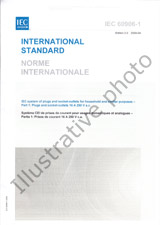We need your consent to use the individual data so that you can see information about your interests, among other things. Click "OK" to give your consent.

IEC 62056-3-1-ed.2.0
Electricity metering data exchange - The DLMS/COSEM suite - Part 3-1: Use of local area networks on twisted pair with carrier signalling
Translate name
STANDARD published on 7.7.2021
The information about the standard:
Designation standards: IEC 62056-3-1-ed.2.0
Publication date standards: 7.7.2021
SKU: NS-1029544
The number of pages: 258
Approximate weight : 805 g (1.77 lbs)
Country: International technical standard
Category: Technical standards IEC
The category - similar standards:
Measurement of electrical and magnetic quantitiesNetworkingElectricity supply systems
Annotation of standard text IEC 62056-3-1-ed.2.0 :
IEC 62056-3-1:2021 describes two sets of profiles: the first set of profiles allows a bidirectional communication between a client and a server. This set of profiles is made of three profiles allowing local bus data exchange with stations either energized or not. For non-energized stations, the bus supplies energy for data exchange. Three different profiles are supported: • base profile: this three-layer profile provides remote communication services; NOTE 1 This first profile was published in IEC 61142:1993 and became known as the Euridis standard. • profile with DLMS: this profile allows using DLMS services as specified in IEC 61334 4 41; NOTE 2 This second profile was published in IEC 62056-31:1999. • profile with DLMS/COSEM: this profile allows using the DLMS/COSEM Application layer and the COSEM object model as specified in IEC 62056 5 3 and in IEC 62056 6 2 respectively. The three profiles use the same physical layer and they are fully compatible, meaning that devices implementing any of these profiles can be operated on the same bus. The transmission medium is twisted pair using carrier signalling and it is known as the Euridis Bus. The second set of profiles allows unidirectional communication between a given Energy Metering device and a Customer Energy Management System. This second set is made up of three profiles. Subclause 4.2.1 to Clause 8 included specify the bidirectional communication using twisted pair signalling and Clause 9 to 9.5 the unidirectional communication using twisted pair signalling. This second edition cancels and replaces the first edition of IEC 62056-3-1, issued in 2013, and constitutes a technical revision. The main technical changes with regard to the previous edition are as follows: • addition of a profile which makes use of the IEC 62056 DLMS/COSEM Application layer and COSEM object model; • review of the data link layer which is split into two parts: – a pure Data Link layer; – a "Support Manager" entity managing the communication media; • ability to negotiate the communication speed, bringing baud rate up to 9 600 bauds. IEC 62056-3-1:2021 decrit deux ensembles de profils: le premier ensemble permet une communication bidirectionnelle entre un client et un serveur. Cet ensemble est compose de trois profils permettant l’echange de donnees par bus en local avec des stations alimentees ou non en energie. Pour les stations telealimentees, le bus fournit l’energie pour l’echange des donnees. Trois differents profils sont pris en charge: • Profil de base: ce profil en trois couches fournit des services de telereleve; NOTE 1 Ce profil a ete publie dans l’IEC 61142:1993 et etait alors connu sous le nom de Norme Euridis. • Profil avec DLMS: ce profil permet l’utilisation des services DLMS tels qu’ils sont specifies dans l’IEC 61334 4 41; NOTE 2 Ce deuxieme profil a ete publie dans l’IEC 62056-31: 1999. • Profil avec DLMS/COSEM: ce profil permet l’utilisation de la couche Application de DLMS/COSEM et le modele objet COSEM tels qu’ils sont specifies respectivement dans l’IEC 62056 5 3 et dans l’IEC 62056 6 2. Les trois profils utilisent la meme couche physique et ils sont entierement compatibles, c’est-a-dire que des dispositifs mettant en ouvre l’un de ces profils peuvent fonctionner sur le meme bus. Le moyen de transmission est la paire torsadee par signal de porteuse et connue sous le nom de Bus Euridis. Le deuxieme ensemble de profils permet une communication unidirectionnelle entre un dispositif de comptage de l’energie (energy metering device) donne et un systeme de gestion de l’energie client (customer energy management system). Ce deuxieme ensemble est compose de trois profils. Le paragraphe 4.2.1 a lArticle 8 inclus specifient la communication bidirectionnelle utilisant le signal avec paire torsadee et lArticle 9 au 9.5 specifient la communication unidirectionnelle utilisant le signal avec paire torsadee. Cette deuxieme edition annule et remplace la premiere edition de l’IEC 62056-3-1, parue en 2013. Cette edition constitue une revision technique. Les principales modifications techniques par rapport a l’edition precedente sont les suivantes: • Ajout d’un profil qui permet l’utilisation de la couche Application et la modelisation objet DLMS/COSEM de l’IEC 62056; • Revision de la couche liaison de donnees qui est maintenant scindee en deux parties: – la premiere est integralement une couche de liaison de donnees; – la derniere, nommee “Gestion du Support”, gere le media de communication; • Capacite de negocier la vitesse de communication, portant la vitesse maximale jusqu’a 9 600 bauds.
We recommend:
Technical standards updating
Do you want to make sure you use only the valid technical standards?
We can offer you a solution which will provide you a monthly overview concerning the updating of standards which you use.
Would you like to know more? Look at this page.



 Cookies
Cookies
